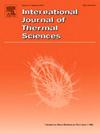低雷诺数涡轮叶片气膜冷却特性研究
IF 5
2区 工程技术
Q1 ENGINEERING, MECHANICAL
International Journal of Thermal Sciences
Pub Date : 2025-05-29
DOI:10.1016/j.ijthermalsci.2025.110015
引用次数: 0
摘要
无人机和大涵道比发动机通常在低雷诺数(Re)条件下运行。这使得涡轮叶片具有明显的气膜冷却特性。本文研究了低Re数(Re = 3.0 × 104、3.5 × 105)和高Re数(Re = 3.0 × 104、3.5 × 105)条件下四排膜孔(吸力侧S1、S2、压力侧P1、P2)的气膜冷却性能。研究了吹气比(M = 0.2、0.5、1.0)对吸侧孔的影响;M = 0.5, 1.0, 1.5(压力侧孔),主流湍流强度(Tu = 2.3%, 15.7%)和主流进口马赫数(Ma = 0.0083, 0.15)对膜冷却效率和换热系数比的影响。结果表明:对于吸力侧膜孔,当M = 0.2和M = 0.5时,低Re数下的膜冷却效果明显差于高Re数下的膜冷却效果,但当吹气比增大(M = 1.0)时,差异减小;在低Re数条件下,增加主流Tu会降低气膜冷却效率,增加换热系数比,而在高Re数条件下则相反。在低Re数条件下,高Ma情况下η值提高28 ~ 45%,而在高Re数条件下,当M = 1.0时,η值反而提高。对于压力侧膜孔,低Re数下的膜冷却效果在较小的吹气比(M = 0.5)下较差,而在M = 1.0和M = 1.5时优于高Re数下的膜冷却效果。在低Re数和高Re数下,Tu值的增加导致换热系数比减小,但在低Re数下,对湍流强度变化的响应不太明显。在两种Re条件下,高Ma初始η值均低于低Ma,但最终优于低Ma。总体而言,低Re数下的气膜冷却性能较差,对湍流强度的变化更敏感,但在高Ma情况下,在更广泛的适用吹气比范围内,气膜覆盖表现出优越的稳定性。本文章由计算机程序翻译,如有差异,请以英文原文为准。
Research on the characteristics of turbine vane film cooling at low Reynolds numbers
Unmanned aerial vehicles and high-bypass-ratio engines typically operate at low Reynolds number(Re)conditions. It results in distinct film cooling characteristics for turbine vanes. This numerical study investigates the film cooling performance of four rows of film holes (S1 and S2 on the suction side, P1 and P2 on the pressure side) under low and high Re numbers (Re = 3.0 × 104, 3.5 × 105). The research focuses on the effects of blowing ratio (M = 0.2, 0.5, 1.0 for suction-side holes; M = 0.5, 1.0, 1.5 for pressure-side holes), mainstream turbulence intensity (Tu = 2.3 %, 15.7 %), and mainstream inlet Mach number (Ma = 0.0083, 0.15) on film cooling effectiveness and heat transfer coefficient ratios. The findings illustrate that, for suction-side film holes, when M = 0.2 and M = 0.5, the film cooling effectiveness at low Re number is significantly worse than at high Re number, but the difference decreases at larger blowing ratios (M = 1.0). Increasing mainstream Tu reduces the film cooling effectiveness at low Re number and increases the heat transfer coefficient ratio, whereas the opposite trend is observed at high Re number. At low Re number, the high Ma case increases the η values by 28–45 %, while this enhancement reverses at M = 1.0 at high Re number. For pressure-side film holes, the film cooling effectiveness at low Re number is poorer at small blowing ratios (M = 0.5), but superior at M = 1.0 and M = 1.5 compared to high Re number. An increase in Tu values leads to a decrease in the heat transfer coefficient ratio at both low and high Re numbers, although the response to turbulence intensity changes is less pronounced at low Re number. At both Re conditions, high Ma initially yields lower η than low Ma but eventually outperforms it. Overall, film cooling performance at low Re number is poorer and more sensitive to changes in turbulence intensity,yet demonstrates superior stability in film coverage across a wider range of applicable blowing ratios at a high Ma case.
求助全文
通过发布文献求助,成功后即可免费获取论文全文。
去求助
来源期刊

International Journal of Thermal Sciences
工程技术-工程:机械
CiteScore
8.10
自引率
11.10%
发文量
531
审稿时长
55 days
期刊介绍:
The International Journal of Thermal Sciences is a journal devoted to the publication of fundamental studies on the physics of transfer processes in general, with an emphasis on thermal aspects and also applied research on various processes, energy systems and the environment. Articles are published in English and French, and are subject to peer review.
The fundamental subjects considered within the scope of the journal are:
* Heat and relevant mass transfer at all scales (nano, micro and macro) and in all types of material (heterogeneous, composites, biological,...) and fluid flow
* Forced, natural or mixed convection in reactive or non-reactive media
* Single or multi–phase fluid flow with or without phase change
* Near–and far–field radiative heat transfer
* Combined modes of heat transfer in complex systems (for example, plasmas, biological, geological,...)
* Multiscale modelling
The applied research topics include:
* Heat exchangers, heat pipes, cooling processes
* Transport phenomena taking place in industrial processes (chemical, food and agricultural, metallurgical, space and aeronautical, automobile industries)
* Nano–and micro–technology for energy, space, biosystems and devices
* Heat transport analysis in advanced systems
* Impact of energy–related processes on environment, and emerging energy systems
The study of thermophysical properties of materials and fluids, thermal measurement techniques, inverse methods, and the developments of experimental methods are within the scope of the International Journal of Thermal Sciences which also covers the modelling, and numerical methods applied to thermal transfer.
 求助内容:
求助内容: 应助结果提醒方式:
应助结果提醒方式:


